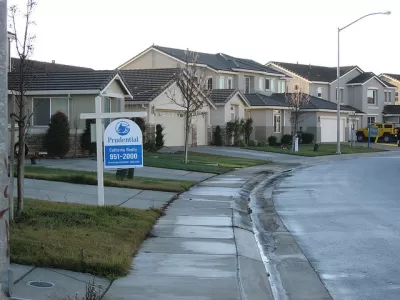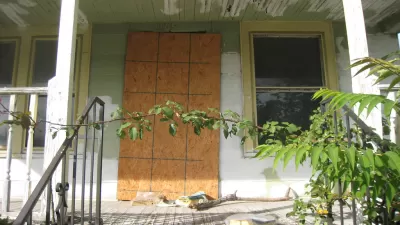Located primarily in the western states, some suburbs were hit hard by the 2008 recession and still haven't recovered. Many have seen an influx of low-income residents and upticks in crime.

Alana Semuels covers Hemet, California, one of the places where last decade's heady housing market drove plentiful construction that ground to a halt in 2008. While many places have since recovered from the economic fallout of that era, locales like Hemet remain stuck.
While distressed "Rust Belt" communities get more press attention, poverty plagues many far-flung suburbs, even some with large, expensive-looking homes. "Such communities have high shares of poverty, many housing vacancies, a large proportion of adults without a high-school diploma, high joblessness, and a lower median income than the rest of the state in which they are located. They also lost jobs and businesses between 2011 and 2015."
Of Hemet, Semuels writes, "employment fell 15.5 percent between 2011 and 2015, while it grew 9.4 percent nationwide. The number of businesses in Hemet dropped 4.8 percent over that time period. The median home price, at $237,000, is still 30 percent lower than it was in 2006."
She goes on, "Hemet’s problems are also the result of structural changes in the economy—changes that have been underway for decades but were masked by the heady days of the housing boom." A rough transition from homeowners to renters, as well as rising crime rates, can be attributed to a range of related problems including negligent absentee landlords, plentiful but low-paying and unstable jobs, and high housing costs in more central locations.
FULL STORY: The Places That May Never Recover From the Recession

Maui's Vacation Rental Debate Turns Ugly
Verbal attacks, misinformation campaigns and fistfights plague a high-stakes debate to convert thousands of vacation rentals into long-term housing.

Planetizen Federal Action Tracker
A weekly monitor of how Trump’s orders and actions are impacting planners and planning in America.

Chicago’s Ghost Rails
Just beneath the surface of the modern city lie the remnants of its expansive early 20th-century streetcar system.

Bend, Oregon Zoning Reforms Prioritize Small-Scale Housing
The city altered its zoning code to allow multi-family housing and eliminated parking mandates citywide.

Amtrak Cutting Jobs, Funding to High-Speed Rail
The agency plans to cut 10 percent of its workforce and has confirmed it will not fund new high-speed rail projects.

LA Denies Basic Services to Unhoused Residents
The city has repeatedly failed to respond to requests for trash pickup at encampment sites, and eliminated a program that provided mobile showers and toilets.
Urban Design for Planners 1: Software Tools
This six-course series explores essential urban design concepts using open source software and equips planners with the tools they need to participate fully in the urban design process.
Planning for Universal Design
Learn the tools for implementing Universal Design in planning regulations.
planning NEXT
Appalachian Highlands Housing Partners
Mpact (founded as Rail~Volution)
City of Camden Redevelopment Agency
City of Astoria
City of Portland
City of Laramie





























